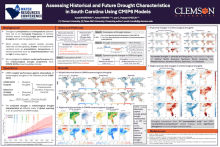Assessing Historical and Future Drought Characteristics in South Carolina Using CMIP6 Models
C. Prakash
Khedun
Clemson University
Kunal Bhardwaj, Department of Civil Engineering, Clemson University
Ashok K. Mishra, Department of Civil & Environmental Engineering, Texas A&M University
Ashok K. Mishra, Department of Civil & Environmental Engineering, Texas A&M University
Poster
Accurately predicting droughts amidst rapid global warming is crucial for effective resource management and policy development, particularly in South Carolina. This study employs the latest Coupled Model Intercomparison Project (CMIP) global climate models to analyze historical and future meteorological drought patterns in South Carolina using the Standardized Precipitation Index (SPI) and Standardized Precipitation Evapotranspiration Index (SPEI). We assess model efficacy against historical observations (1951-2014) and project drought changes at key IPCC warming thresholds (1.5°C, 2°C, and 3°C). Our results show that, in South Carolina, the bias in SPI drought characteristics indicates a slight underestimation in drought duration and severity (up to 10-20%) and a moderate overestimation in drought frequency (up to 10-20%). Similarly, the bias in SPEI drought characteristics reveals a slight underestimation in drought duration and severity (up to 10-20%) and a moderate overestimation in drought frequency (up to 10-20%). Projections indicate that under all warming scenarios, South Carolina is expected to experience a slight decrease in SPI drought duration, frequency, and severity, while SPEI projections suggest a slight increase in drought duration, frequency, and severity. This discrepancy underscores the importance of including temperature and evapotranspiration in drought assessments, as the SPEI projections highlight potential worsening drought conditions with increasing global temperatures. Our study highlights the wide variability in drought responses among GCMs, emphasizing the necessity for accurate model selection. By analyzing the agreement of drought characteristics from the GCMs against observations, we caution against over-reliance on projections alone. The multimodel approach improves performance on a historical basis, translating to reduced uncertainties in future predicted droughts. This study underscores the complexity of future drought patterns in South Carolina, which would necessitate a wide range of strategies for mitigation and adaptation to safeguard against escalating drought risks in a warming climate.
Poster PDF

Meeting homepage